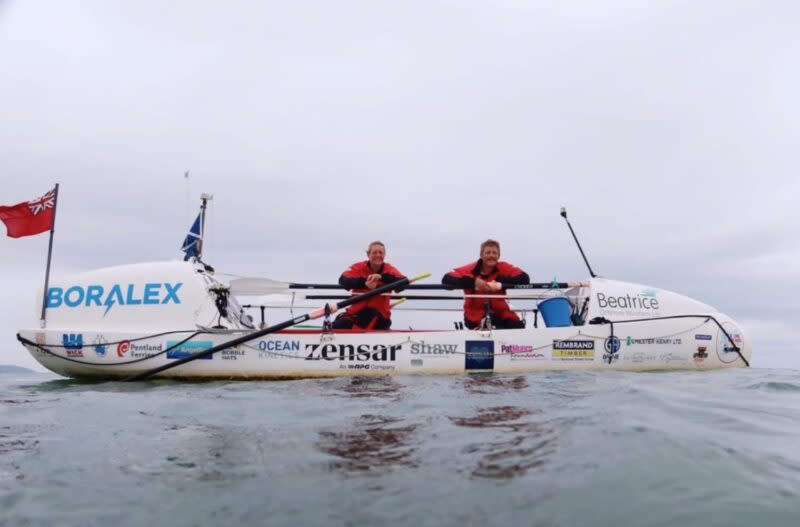Since our last ocean rowing report, all crews have completed their journey and no one has reached the finish.
Atlantic Ocean
Tom Waddington: Waddington (UK) attempted to cross the North Atlantic from Canada to the UK. Although new to the sport, he wanted to break the 39-day speed record. With wind pushing against him almost every stroke, he only reached the halfway point on day 41.
He waited for days on the para-anchor to row, and only had an occasional day with favorable conditions. He also capsized several times, damaging or losing some equipment, including his Emergency Position Indicating Radio Beacon (EPIRB). Then his fortunes changed. The waves were big, but they were moving in the same direction as he was. Riding the waves, he started racing toward the United Kingdom.
With just 152km to go, a new set of difficulties loomed. Waddington had set his sights on Penzance on the British mainland. But strong southerly winds began to push him north towards the Isles of Scilly, just offshore from his finish line. His land team urged him to row as far south as possible to counter the oncoming wind, but it wasn’t enough. He was still heading straight for Scilly.
His plan then changed to rowing around the top of the islands. After rowing for over 18 hours without rest, he was completely exhausted. It became clear that he would not make it to Penzance.
As the wind and tides increased, Waddington called the Royal National Lifeboat Institution (RNLI) to help him to safety.
Patrick Favre: Favre (FR) has set a new speed record for solo rowing on the North Atlantic. He rowed from Canada to Ireland in 32 days, breaking the previous record by seven days.
He initially started in Newfoundland, but stopped after three days in Trespassey Harbour. Wind and heavy fog made rowing too dangerous. After two days he picked up his oars and steered the boat towards France. His record time was taken from his departure from Trespassey and does not include the first three days.


Despite his rapid progress, there were many tricky spots. Halfway through, the wind kept pushing him off course. On day 18, he woke up to find himself in the same position he had started on day 17, despite a full day on the oars in between. Fortunately, this was Favre’s ninth Atlantic crossing and he was unfazed.
“No crossing of the North Atlantic takes place without a backward loop,” Favre said.
In the later stages of the voyage he used the para-anchor frequently. During a day with 35 knots and 50 knots of wind he capsized and broke the autopilot. Nevertheless he made good progress, even in turbulent conditions.
However, the wind and currents were pushing him sideways, away from France. With a strong headwind on the horizon, it was vital that he reach land as quickly as possible. His new finish line was the south of Ireland.
Around the United Kingdom
The Long Row House: Allan Lipp and Mhairi Ross attempted to row around the coastline of the British mainland. They set off from Wick in the far north of Scotland on 1 June, rowing in a clockwise direction.


They had hoped to break the 60-day circumnavigation record, but were unable to do so. After 80 days, they broke off their journey at Tobermory. Exhausted, they felt it was unsafe to continue in the forecast weather.
“We have hit the pause button and are now moored in Tobermory Marina. It has been tough getting to the start. We have given nothing but blood, toil, sweat and tears as we have worked tirelessly to succeed in our unsupported attempt to row around Britain. Our journey has taken us to places we never knew existed, mentally, physically and sometimes geographically,” they wrote.
Northwestern passage
NWP Expedition: This crew had a dramatic end to their Northwest Passage journey. This year, they returned to finish the journey they began in 2023. Last year, they rowed the first 2,600 km of the route before weather stopped them.
While the Northwest Passage is always challenging, the remaining 1,100 km to Point Barrow is considered a slightly less challenging section. However, they missed the trip again.
In early September, they awoke to find their boat’s cabins filled with water. They estimated that the bow cabin alone contained 40 gallons of water. The team began a frantic search for the leak. There was a three-and-a-half-foot tear in the hull. The weather had been changeable throughout. With many difficult moments, it remains a mystery where exactly the leak had originated.
Their next step was to sail to Paulatuk as quickly as possible, patch up the boat with whatever they could find, and then sail straight back to Cape Horn to finish their rowing trip.
But before they could begin, they needed a temporary solution to move the boat at all. Skipper Leven Brown managed to repair the boat enough to get her back in the water, but a few hours later the emergency engine gave out. Still, determined not to call for help, the four-man crew rowed more than 300km in a sinking boat in 10 days.
Finally they reached Paulatuk.
“We have assessed the damage to the boat in Paulatuk and it is too extensive to continue. Are we done? At least for now,” Brown wrote on social media.
The post Ocean Rowing overview for September first appeared on Explorers Web.







